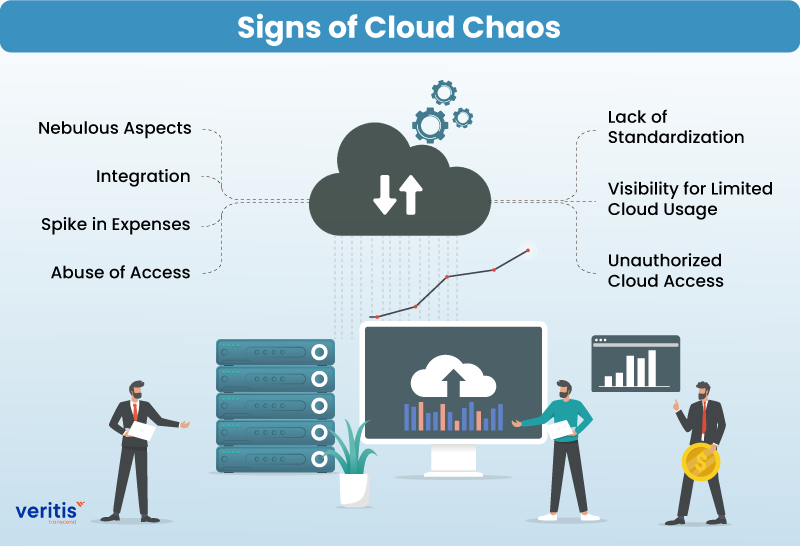
Cloud is an enticing tech innovation that many companies across the globe are capitalizing. To stay competent, businesses are integrating tech with their solutions. Unfortunately, at times, this integration is hasty, and that leads to counterproductive results. When the organization thinks Cloud will better their market stance, the results that pummel the business narrate otherwise.
Sorted data management is among the many advantages that cloud technology development has given enterprises. Businesses integrate cloud technology into their operations to stay up with this expanding trend. Yet, cloud integration can occasionally be a complicated process with space for mistakes that lead to a lousy cloud adoption strategy.
Leveraging the full potential of cloud computing can be improved by an effective cloud strategy. Businesses are at risk of system failure, malware, data loss, and other threats.
Companies operating with this mindset run the risk of dealing with process inefficiencies, redundant capabilities, and instances of shadow IT. Although many businesses need to address it as such, cloud management is just as crucial as more conventional corporate operations. Companies frequently need more knowledge or time to develop a cloud management program that satisfies current demands. A cloud adoption strategy management platform will most likely be the solution if you’re looking to organise your team’s knowledge and take the complexity out of communicating with dozens of multi cloud infrastructure services. But this raises a question.
Consider a scenario in which your business has both on-premises infrastructure and a presence in a cloud provider’s infrastructure. Still, the complexity and cost have not been reduced as much as you had hoped. If that’s the case, implementing a hybrid cloud strategy can be the solution you’re looking for.
A hybrid cloud strategy is made up of at least two different computer environments that communicate and use the same set of applications. It could consist of many private or public clouds, a virtual or bare-metal environment linked to a cloud, a mix of private and public clouds, or both.
Some signs indicating a hasty adoption include massive disgruntlement within the in-house teams. Ranging from resource management headaches to spikes in efforts and expenses, the organization would descend into a chaotic situation.
Also Read: Cloud Security Automation: Best Practices, Strategy, and Benefits
However, the ‘Cloud chaos’ shall disappear from the scene if the organization pays heed to these symptoms. So, what are these cloud strategy services symptoms that one ought to look out for? Let’s have a look.

1) Nebulous Aspects
After migrating, if the teams are clueless as to how to proceed with the Cloud or if the management has no clarity about their expenses, then it is safe to say that the company is in the eye of the storm. This tends to happen when the company doesn’t train its in-house staff to go about the cloud security strategy. The management should not allow themselves to get carried away by the glitzy aura that surrounds the cloud transformation strategy.
It is pertinent to understand that top-notch cloud solutions are oceanic by nature. It is a given that an untrained specialist will get lost in the Cloud labyrinth. The onus is on the management to discuss every concern and address them with due diligence. The production teams should convey to the management what Cloud utilities are required for seamless cloud operations.
2) Integration
Wanting to ingrain cloud strategy services in every business solution is unwise. Cloud is a tech meant to boost new-age technological solutions. It is a solution where one can develop, deploy, and maintain digital solutions and reduce dependency on the on-premises servers. And wanting to achieve complete integration with the concerned solutions is impractical. Integrating Cloud tech in a bullish way accelerates production chain breakdown.
At best, cloud transformation strategy should be perceived as a shot-in-the-arm. To realize the optimal integration, the management and the DevOps teams should achieve concurrence about the business goals and the implementation process on cloud strategy consulting.
Also Read: Cloud Cost Optimization and Management: Trends, Analysis and Strategy!
3) Spike in Expenses
Cloud is a treasure trove in terms of features. However, due to the vastness of the technology, it is difficult to comprehend all the features the company is inadvertently paying for. Having such features is like paying for TV channels which we never watch. The primary side effect that crops up with a lack of clarity on features is the rise in expenses. Cloud tech is about streamlining monetary spending. The purpose of Cloud is defeated when the company dives headfirst without acknowledging the oceanic variety of cloud transformation strategy features.
To cauterize the unwanted problem, the organizations should have their plan based on their extensive research. The plan should also detail how the cloud migration strategy will be implemented. This research-based planning will allow the company to control its expenses and ultimately trim them.
4) Abuse of Access
Having a poor Cloud governance policy allows the users to have a free run with the tech. Post-migration, if the company doesn’t monitor the usage of the Cloud, it results in chaos. From cloud security strategy breaches to wastage of efforts, the company will be engulfed in problems of sorts.
Additionally, the multi cloud infrastructure policy should define the duties of the people who are assigned to work on the cloud strategy consulting. Without a taut policy, confusion will ensue as employees will be clueless about their responsibilities. Therefore, it is in everyone’s best interest that the organization adopt a strict Cloud governance policy without hindering productivity.
5) Lack of Standardization
Adopting and implementing reliable cloud technology in your business solutions becomes more complicated when automation and standardization are not strengthened. It merely increases the number of gaps in your cloud plan. Managing your tasks, cloud costs, and troubleshooting can be challenging.
In addition, interoperability is a crucial element in maximizing the return on investment in cloud computing, according to most cloud experts. A standardized cloud framework is needed to ensure interoperability between cloud systems. The inconsistent security and cloud portability that results from this problematic scenario.
6) Visibility for Limited Cloud Usage
The inability of a company to comprehend the threat and security breaches within the business results in limited cloud utilisation visibility. Imagine that one of your employees accidentally uploads private company information to a public server without your authorization or consent. Your company is vulnerable to these errors because of cloud utilization ignorance.
You must develop a complete solution and give your staff the required education and training if you want to increase your cloud implementation visibility. Revising your cloud control, monitoring, and security policies would be beneficial. Adopting AI/ML methodologies and investing in firewall methods can be excellent initiatives.
7) Unauthorized Cloud Access
One of the significant worries with cloud computing is a data breach or unauthorized access to data. The most recent survey indicates that 79% of businesses have encountered at least one cloud implementation data leak.
A firm may suffer as a result of a data breach. The company’s reputation may also be questioned regarding how the business operations are affected. Effective tactics like having the proper encryption, a reliable backup plan, maintaining your security, and other preventative steps must be adopted to protect yourself against a disastrous data breach. That is the only solution to stop illegal cloud access inside and outside your company.
Final thoughts
Poor planning and communication gaps are the underlying aspect that unites all these symptoms. The management and production teams should sport a hand-in-glove relationship when it comes to Cloud tech implementation. It is always wise to rope in a cloud service provider to help you proceed with Cloud migration and maintenance.
Veritis is a formidable force in the Cloud arena. Based out in Texas, we help you transcend to the next level. Collaborate with us and unlock your fullest potential.
Got Questions? Schedule A Call
More Articles:
- Top 5 Reasons for Cloud Migration Failure!
- Things to Consider Before Tailoring an Optimal AWS Cloud Strategy
- How to Plan an Effective Cloud Disaster Recovery Strategy?
- A Know-How of Cloud Migration: Azure and Its 4-Step Strategy
- Best Practices that Lead to Good Cloud Governance
- AWS vs Azure vs GCP: Breakdown of Cloud Migration Services